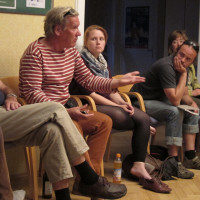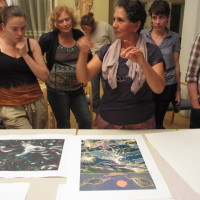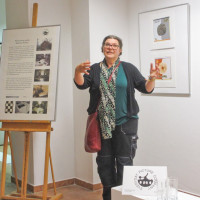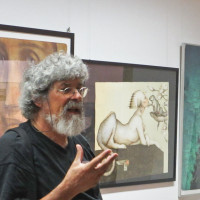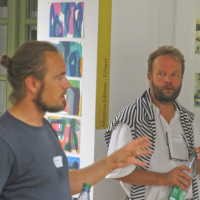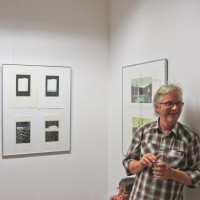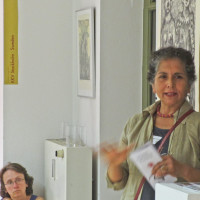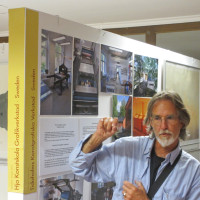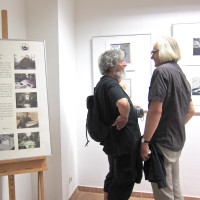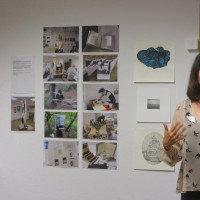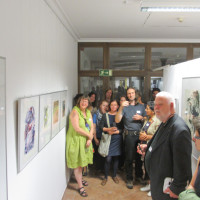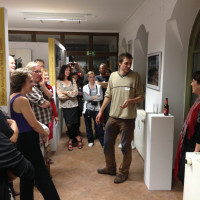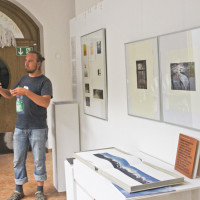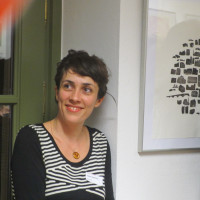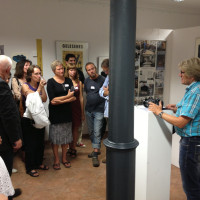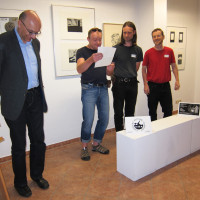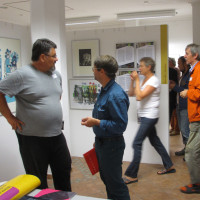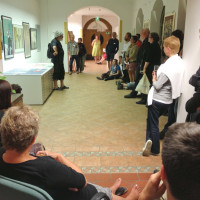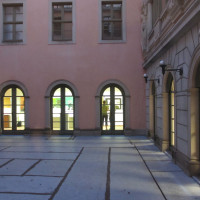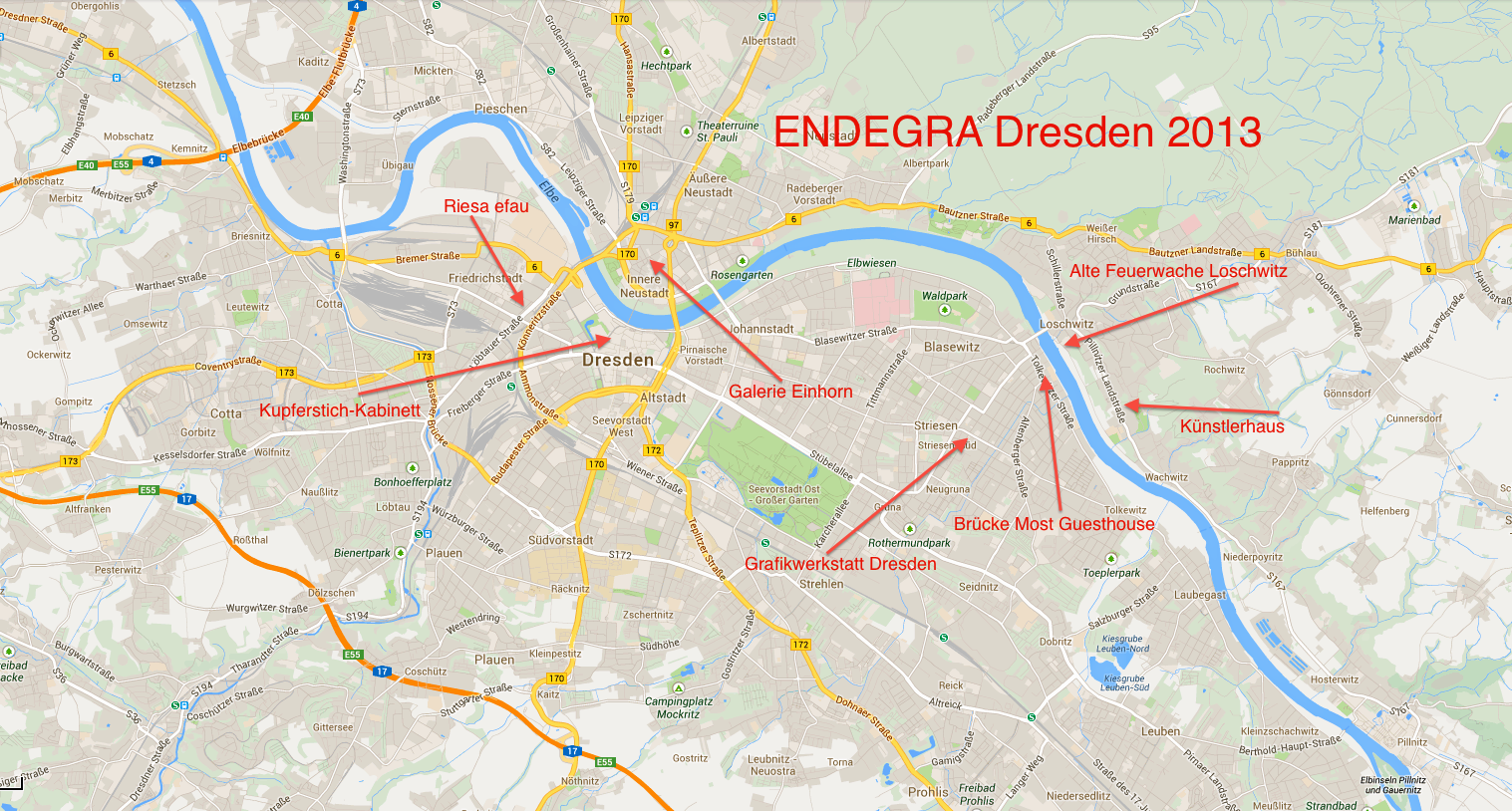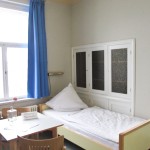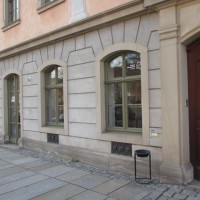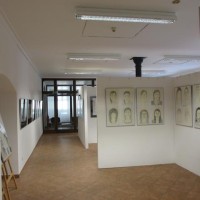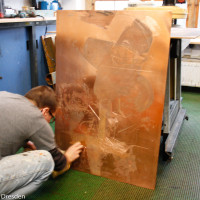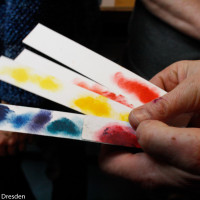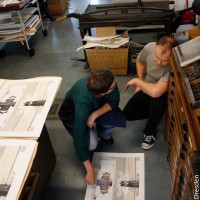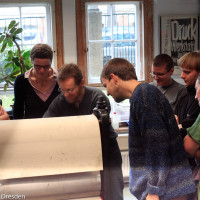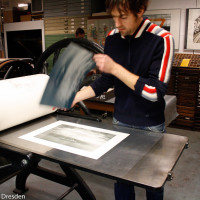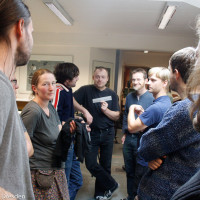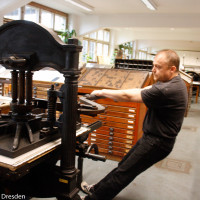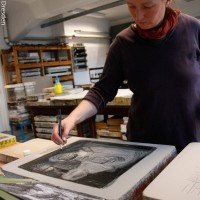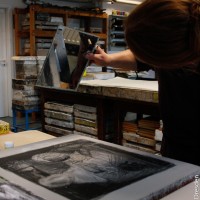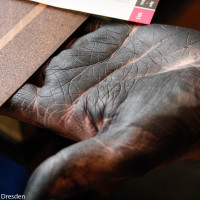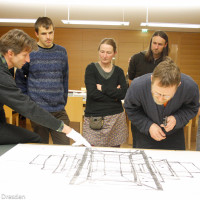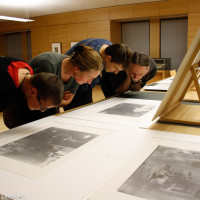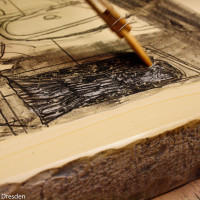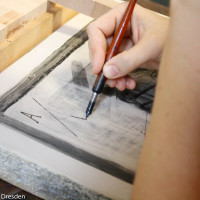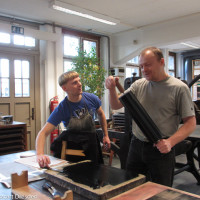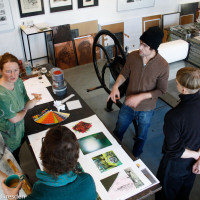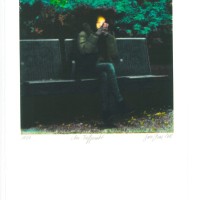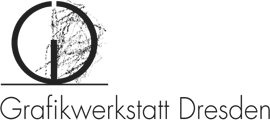Open Table – Presentation
Varje kväll bestod möjlighet att presentera sitt arbete till deltagarna. På så livliga diskussioner om grafiska finesser uppstod.
Typostudio SchumacherGebler Dresden
Besök till Typostudio SchumacherGebler Dresden – med sakkunnig personlig introduktion till samlingen av Mr. SchumacherGebler personligen.
Originalgrafiska Leporello
De tryckplåtar av alla deltagare i utflykten till Saxon Schweiz omvandlades till ett originalgrafiska Leporello.
ENDEGRA med tryckplattor i Sächsische Schweiz
Art-landscape and place of landscape art – Dresden and Printmaking-role since the 15th century in Saxony. Läs mer →
Verkstad-atmosfär
Dessa bilder är ögonblicksbilder från vardagen i veckan ENDEGRA-Dresden och visar den mycket kommunikativ Atmosfär.
Presentation av verkstäderna i utställningen Galerie EINHORN
Deltagarna i ENDEGRA Dresden 2013 presenterade sin Possitionen och beskrev workshops representerade – med spännande fakta om situationen för printmaking workshops uppdagades i respektive land, för kulturell finansiering av politiken och strukturen av de konstnärer som arbetar där. Sedan placerade frågorna om den andra:
- Bolaget Vardagsbilder Lithographic Studio | Sweden
- Steindruckerei Ernst & Erika Hanke | Switzerland
- Hjo Konstskola Grafikverkstad | Sweden
- Albatross Editions | Finland
- Bolaget Vardagsbilder Lithographic Studio | Sweden
- Bolaget Vardagsbilder Lithographic Studio | Sweden
- Skaraborgs Konstgrafiska Verkstad | Sweden
- Skaraborgs Konstgrafiska Verkstad | Sweden
- Konstnärernas kollektivverktad | Stockholm
- Fyns Grafiske Værksted | Danmark
- Tidaholms Konstgrafiska Verkstad|Sweden
- Typostudio SG | Germany
- Grafikverkstan Godsmagasinet | Sweden
- Vilnius Graphic Art Center | Lithuania
- Vilnius Graphic Art Center | Lithuania
- Göteborg Art School | Sweden
- Göteborg Art School | Sweden
- Atelier | France
- Saima University of Fine Arts, Imatra | Finland
- Konstnärs Kolektiv Verkstatt Stockholm|Sweden
- Lahti Printmakers Association | Finland
- Lahti Printmakers Association | Finland
- Lahti Printmakers Association | Finland
- Grafikwerkstatt Dresden | Germany
- Atelier | France
- Academy of Fine Arts in Wocław | Poland
- Association Atelier de Gravure Bo Halbirk | France
- Grafikwerkstatt Dresden | Germany
- Association Atelier de Gravure Bo Halbirk | France
- Kulturverein Riesa efau | Germany
- Alte Feuerwache Loschwitz | Germany
- Steindruckerei Ernst & Erika Hanke | Switzerland
- Kulturverein Riesa efau | Germany
- Leporello: ENDEGRA in Sächsischer Schweiz
- Galerie EINHORN | Germany
- Grafikwerkstatt Dresden | Germany
ENDEGRA möter i Dresden
Välkomna i Dresden
Utställningen i galleriet EINHORN designades gemensamt av alla deltagare på samma dag för ankomst – detta var en omfattande presentation av varianter i de olika workshops som är involverade i ENDEGRA-Dresden 2013. Den officiella vernissagen kommer på torsdag.
- Grafikwerkstatt Dresden | Germany
Giltigt program
Serigrafie Riesa efau: Markus Trage 017623340133
Wednesday 14.8.
Typostudio SchumacherGebler Dresden
Großenhainer Straße 11
01097 Dresden
+49 351 808520
Discussion 16. August
For the discussion in Dresden August 16, 2013 – with best regards from the moderators Nina Bondeson & Jim Berggren!
What do we need to agree on? What do we not need to agree on?
When we discuss how we want to continue the work with ENDEGRA, it is important to sort out what it is we need to agree on and what is it we do not have to share opinions about, in order to strengthen and extend opportunities within printmaking. These two questions are at the same time a supportive reverse gear if a discussion comes to a dead end, since the only way forward from a dead end is to back out of it.
We live in a floating modernity, says sociologist Zygmunt Bauman. Things change quickly and we are all expected to be flexible and change with it. Whatever we think of that, it has affected our ways of thinking and acting in the last 3 – 4 decades. Our ENDEGRA network is itself a consequence of this floating new world. To develop the network, we have to identify terms and pre-conditions in order to adapt to or to oppose the changes we see. Either way, we need to have good arguments to apply for co-funding for work and projects and to make politicians and decision makers understand that art, in all forms, is a founding necessity in a democratic society.
Our workshops are our physical anchor grounds. Our knowledge and skills are not thretened by change, only by lack of money.
In art-making, there are good reasons to reach a consensus on HOW art is made in order to be able to provide the necessary conditions for it to be made. It is, for instance, of little use to deny the need of machinery and tools we use in artistic printmaking. If you don ́t have what it takes, no print will be made. This, of course, applies to any art-making, from huge opera projects to needle point: production terms must be adequate. You cannot talk your way out of them.
So, to secure good quality in art-making possibilities, we have to agree on the production terms. But we do not have to agree on how we regard the outcome of artistic production. The artistic quality, how
art looks, what it expresses or what things are called does not benefit from such agreements. When it comes to that, we can, and indeed should, have interesting and agonistic1 discussions and ”fights”.
What we need, to work with and develop printmaking, has to be separated from subjective opinions
about art and different formalities in art. The conceptual framework must be flexible and open in respect of different standpoints and ways of working. Respect in these matters does of course not mean that the differences can ́t be argued and discussed. Quite the opposite! Discussions about art are vital, but unlike discussions about artistic prodution terms, discussions about art don ́t have to end in a consensus to be nutritious and worthwhile.
This attitude towards art and art making mirrors what is needed (but not implemented) in society as a whole. We come from different traditions, different backgrounds. We all carry heritage that might occur
strange to others. In the floating new world everyone of us is a stranger sometimes and we have to be able to deal with ambivalence and ambiguity.
Art is good here. To tell about the world through art presents an ambivalent language situation in itself.
Art communicates through our different experiences. That is: art communicates through my ability to open my own experience as a tool for interpretation, a tool to create meaning. (This ability has to be trained. It is a skill, like reading and writing. But we don ́t acknowledge it in our elementary schooling. That has to do with our ”Newtonism”, the mechanical view on life that we have extracted from Newton ́s theories, but that he didn ́t have himself… : )
So; while we develop and make use of our network, we articulate the terms and conditions needed in
artistic printmaking. It gives us great possibilities to show ourselves and others how to not avoid, but
make use of, the ambivalence and ambiguity of our time and of course: the ambiguity it allways has
been to be human and live in the world.
What do we need to agree on to develop ENDEGRA and conditions for printmaking?
What do we need to be able to disagree on to develop ENDEGRA and conditions for printmaking?
Looking forward to Dresden 11 – 17 august!
Bokade: 35 gäster
Vi är glada över att ha så många bokning – 35 gäster och extra konstnärer från Dresden ska är där. Vi skickar nu bekräftelser för accommodation. Det finns inget mer rummet längre tillgänglig.
Obs: Programmet uppdateras ständigt.
Hälsningar Peter
Några boende platser finns …
Vi har idag 33 registrerade gäster, några boende platser finns fortfarande tillgängliga. Programmet är uppdaterad – Vi befarar att veckan är inte tillräckligt för alla intressanta punkter …
Vi sess i augusti, Peter!
Art-landscape and place of landscape art – Dresden
Dr. phil. Anke Fröhlich (Dresden):
„Topography – Typography“
Art-landscape and place of landscape art – Dresden / Typography as a tool for intellectual and emotional knowledge / Printmaking-role since the 15th century in Saxony
Monday 12th: Lecture
Thursday 15th: Presentation of selected prints and discussion
In the rich tradition of the saxon history the graphical arts plays a great rule. From the beginning of engravings and woodcuts since around 1500 graphical prints served as single-sheet woodcuts, flyers or book illustrations; especially because Saxony in that time was a main territory of the theological movements reformation and counter reformation. Lukas Cranach and his followers found very popular compositions into that disputes – and allways in closely contact with the printed word. So the printed artworks by that time enclosed the whole knowledge and the images about the world and god.
Also in the following epochs like the enlightement in the 18th century Dresden was a center of fine arts including prints. Leipzig had a lot of printing houses and for them many artists made very tastfull illustrations for the book market.
But in Dresden growes a school of gifted landscape painter who also made engravings and etchings. There is a very close relation between topographical artworks, the presentation of the natural area and thinking about world. Details of composition, figures and so on includes a special view on the world.
This view is in Baroque very different to the age of sensitivity or Romantic, the highpoint of landscape painting in Saxony. It changed from a view over the whole world to the view on details and reflect the moved relation between individual and god. Famous artists like Dietricy, Adrian Zingg or Johann Christian Klengel and there followers found the environments of Dresden and the mountains “Sächsische Schweiz” as places an topics of a new kind of beauty. Caspar David Friedrich used the nature as symbol for the human soul.
With a lot of impressive examples Dr. Anke Fröhlich will show the development of using woodcuts, engravings and etchings in the german art history especially in Saxony and considering the rich tradition of landscapes.
Also the meetings will be in Brücke/Most
Also the meetings are in Brücke/Most-house: beautiful garden, large salon and the river Elbe is right next door … and for August we ordered the best weather!
Historic guesthouse on the river Elbe
ENDEGRA-Dresden participants will stay in a famous historic guesthouse on the river Elbe, 29 Beds in shared rooms are available. In the neighborhood there are enough hotel standard rooms and single rooms, more expensive.
Brücke/Most-Stiftung
Reinhold-Becker-Straße 5
D-01277 Dresden
Gesäll Vandring
2019 | Jana Madle-Elmerhaus
Kommunikationsdesignerin · Typografin
☞ Schriftsetzerin in Ausbildung auf TypoWalz
 Auf zur nächsten Station – Der Tag beginnt freundlich, die Sonne heißt mich willkommen. Diesmal kenne ich weder die Örtlichkeit, noch weiß ich, wem ich begegnen werde. Der Hinweg führt mich vorbei an Gründerzeit-Villen und schon die Straßenschilder begrüßen mich in einer Serifen-Schrift, die aussieht wie die Garamond. 600 Quadratmeter Glück – gleich am Eingang der Grafikwerkstatt hängt einladend eine Druckwalze als Namensschild und ich weiß sofort, dass ich hier richtig bin. Dann trete ich ein in eine 600 m² große lichtdurchflutete Werkstatt, Läs mer →
Auf zur nächsten Station – Der Tag beginnt freundlich, die Sonne heißt mich willkommen. Diesmal kenne ich weder die Örtlichkeit, noch weiß ich, wem ich begegnen werde. Der Hinweg führt mich vorbei an Gründerzeit-Villen und schon die Straßenschilder begrüßen mich in einer Serifen-Schrift, die aussieht wie die Garamond. 600 Quadratmeter Glück – gleich am Eingang der Grafikwerkstatt hängt einladend eine Druckwalze als Namensschild und ich weiß sofort, dass ich hier richtig bin. Dann trete ich ein in eine 600 m² große lichtdurchflutete Werkstatt, Läs mer →
Introduce your workshop!
We invite all of all participating workshops to introduce yourself – to show examples of art and how it was made – please contact us soon.
Peter Stephan
Galerie EINHORN is reserved for our week
Now I have finally found the perfect opportunity for our exhibition to present the print-workshops. The Gallery EINHORN (JugendKunstschule Dresden/Kinder- und Jugendgalerie EINHORN, Königstraße 15, 01097 Dresden) which is the best address in Dresden, is reserved for the week. So we have a place each other exchange views as ENDEGRA group, and but also to invite for an official press conference on end or during our meeting.
Now we invite all of all participating workshops to present – especially the professional workshops and examples of art and how it was made – and we are happy about ideas … please contact us soon.
Peter Stephan
We are just planning
Topography – Typography
The next ENDEGRA meeting starts in the landscape of Middlegermany and Saxony with its vast traditions in art and culture, where printmaking has played a vital role since the 15th century. In the romantic era, that emanated in the 18th century, visual artists from the Dresden area started to paint the lovely, strange and always expressive and characteristic landscape along the river Elbe and in the Sächsische Schweiz. They depicted the outer landscape to use it as a metaphor for an inner landscape. Their art led to a widely spread appreciation of the landscape, as a physical place to visit and as pictures that told about our lived experiences.
Topography is a scientific tool to understand conditions and preconditions of an investigated terrain. As a metaphor we can use it to get a better understanding of our situation as artists and printmakers today. How would we describe the ”landscape” where we live and work as artists and printmakers? What maps do we need to draw to find our ways? What do we need to consider in the present artistic ”ecology”?
Typography, on the other hand, was always a tool to bring both intellectual and emotional knowledge. To print and to spread that knowledge we need freedom of expression and liberty of the press. We live in a society that wants to develop and deepen democracy. As printmakers, we have a responsibility: not just to save methods and tools as a cultural heritage, but to save preconditions for independent artistic language possibilities and expression. What are the preconditions of printmaking today? How can we understand, develop and defend our position as publishers of free press and independent and free art?
Neue Blätter
- Christoph Roßner – Auflage 20, Algrafie, 6 Farben, verfügbar: Blatt 11/20 – 20/20
- Elisabeth Richter – Auflage 20, Algrafie, 6 Farben, verfügbar: Blatt 11/20 – 20/20
- Stefan Krauth – Auflage 20, Algrafie, 6 Farben, verfügbar: Blatt 11/20 – 20/20
- Svea Duwe – Auflage 20, Algrafie, 6 Farben, verfügbar: Blatt 11/20 – 20/20
- Tanja Pohl – Auflage 20, Algrafie, 6 Farben, verfügbar: Blatt 11/20 – 20/20
- Thomas Prochnow – Auflage 20, Algrafie, 6 Farben, verfügbar: Blatt 11/20 – 20/20
Ausstellung in der Galerie Baer
Herzliche Einladung zur Ausstellung ”Handpressendrucke Dresden 2012” in die galerie baer
In Zusammenarbeit mit der Galerie Baer, der Hochschule für Bildende Künste Dresden, dem Kupferstich-Kabinett der Staatlichen Kunstsammlungen und dem Amt für Kultur und Denkmalschutz hat die Grafikwerkstatt zum Workshop “Handpressendrucke Dresden 2012” eingeladen. Es arbeiteten Svea Duwe, Stefan Krauth, Tanja Pohl, Thomas Prochnow, Elisabeth Richter und Christoph Roßner mit den Ausdrucksmöglichkeiten der originaldruckgrafischen Verfahren. Die Ausstellung in der Galerie Baer, zu der wir recht herzlich einladen, soll Ergebnisse zeigen und den Abschluss der zwei Werkstattwochen bilden.
»Handpressendrucke Dresden 2012«
SVEA DUWE, STEFAN KRAUTH, TANJA POHL, THOMAS PROCHNOW, ELISABETH RICHTER, CHRISTOPH ROSSNER
16.11. bis 28.11.2012

Eröffnung am Freitag, dem 16. November, von 18 bis 21 Uhr
Opening on Friday, November 16, 6 til 9 p.m.
Party 9 p.m. Bar Holda, Martin-Luther-Platz 4
Sie sind herzlich eingeladen/We cordially invite you.
Tilman Bruhn, Claudia und/and Patrick-Daniel Baer
galerie baer I raum für aktuelle kunst
louisenstr. 72
d-01099 dresden
fon: +49(0)351-6465033
mobil: +49(0)173 – 5641211
fax: +49(0)351-6465032
öffnungszeiten: di-fr 11-18 sa 12-16
Eröffnung von Handpressendrucke Dresden 2012
Montag, den 5. November 9 Uhr erwarten wir die teilnehmenden Künstlerinnen und Künstler zur Eröffnung von Handpressendrucke Dresden 2012 in der Grafikwerkstatt. Wir Drucker haben heute endlich alles vorbereitet, die Maschinen auf Hochglanz gebracht und sind nun gespannt …
Handpressendrucke Dresden 5. – 16. November 2012
KünstlerInnen Die Drucker Tagebuch Handpressendrucke
In Zusammenarbeit mit der Galerie Baer, der Hochschule für Bildende Künste Dresden, dem Kupferstich-Kabinett der Staatlichen Kunstsammlungen und dem Amt für Kultur und Denkmalschutz lädt die Grafikwerkstatt zu einem Workshop ”Handpressendruck” ein. Ziel ist die Förderung von Künstlerinnen und Künstlern, die mit originaldruckgrafischen Techniken arbeiten wollen, außerdem die Pflege von Originaldruckgrafik in Qualität und Vielfalt.
Im Workshop ”Handpressendrucke Dresden 2012” arbeiten Svea Duwe, Stefan Krauth, Tanja Pohl, Thomas Prochnow, Elisabeth Richter und Christoph Roßner mit den Ausdrucksmöglichkeiten der originaldruckgrafischen Verfahren. Eine Ausstellung in der Galerie Baer bildet ab 16.11. den Abschluss.
Der Workshop soll sich u.a. der Algrafie widmen. Dieses Verfahren wird in der Grafikwerkstatt seit den 1970iger Jahren gepflegt und weiterentwickelt. Heute verbindet unsere spezielle Variante der Hand-Algrafie, in der Radierpresse auf Büttenpapier gedruckt, nahezu ideal moderne Bildmedien mit klassischer Originaldruckgrafik – mit Lithotusche und Lithokreide direkt gezeichnet oder als Materialabdruck, Umdruck, Kopieübertragung, Collage, Frottage, Fotogramm bis hin zu Übertragungen natürlicher Halbtöne in einen Belichtungsprozeß mit oder ohne fotografische oder digitale Veränderungen.
Innerhalb der 10 Tage können die KünstlerInnen in der Grafikwerkstatt Dresden in Hochdruck, Algrafie und Radierung frei arbeiten, wobei ebenso großer Wert auf den fachlichen und künstlerischen Austausch gelegt werden soll. Frei arbeiten bedeutet: es steht allen sechs TeilnehmerInnen eine Presse und vollständige Arbeitsumgebung zum eigenen Experimentieren zur Verfügung und wir drei Drucker der Grafikwerkstatt, Torsten Leupold, Udo Haufe und Peter Stephan, unterstützt durch Simon Faulhaber stehen zur drucktechnischen Beratung zur Seite.
Zusätzlich bieten wir in den Werkstattwochen die Herstellung eines mehrfarbiges Blattes für die „Edition Handpressendrucke“ an. Maximal 6 Farben werden als Ausführungsarbeit gedruckt – täglich je eine Farbe als Demonstration der Technik Algrafie auf der Offsetandruckpresse, auf Hahnemühle Büttenpapier in der Größe von 27 x 39 cm.

